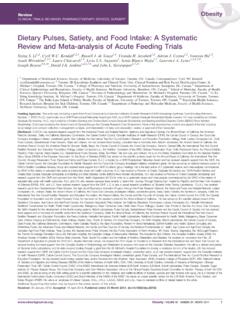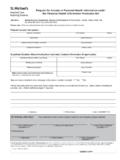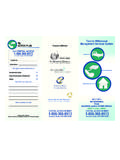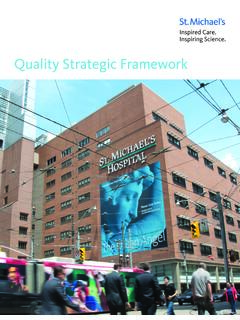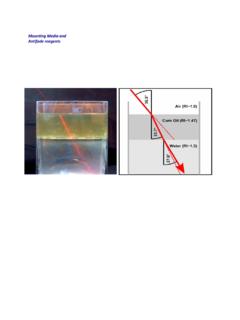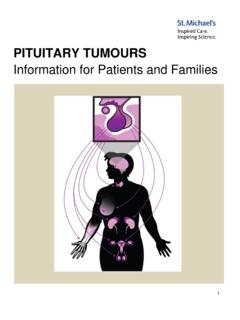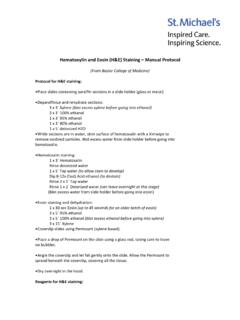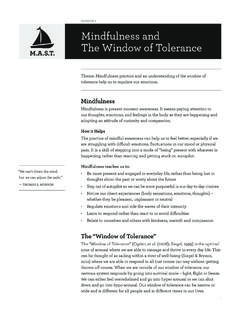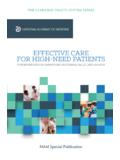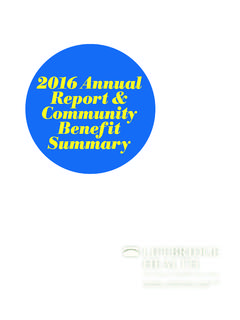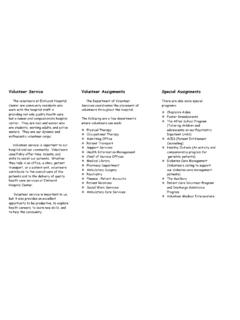Transcription of We care. - St. Michael's Hospital
1 REPORTSEPTEMBER 2013We ask because We language do you feel most comfortable speaking in with your health - care provider?Which of the following best describes your racial or ethnic group?Do you have any of the following disabilities?Will you please provide us with information about yourself?This information will increase access to services and improve the quality of funding and support from the Toronto Central ask because we careThe Tri- Hospital + TPH health Equity Data Collection Research Project ReportSTEERING COMMITTEE:Branka Agic Centre for Addiction & Mental HealthSimone Atungo mount Sinai HospitalCaroline Bennett-AbuAyyash mount Sinai HospitalRobert Coughlin Toronto Public HealthMargaret de Wit Toronto Public HealthCindy Fedell mount Sinai HospitalMarylin Kanee mount Sinai HospitalKwasi Kafele formerly Centre for Addiction & Mental HealthRuby Lam Toronto Public HealthJanet Mawhinney Centre for Addiction & Mental HealthKwame McKenzie Centre for Addiction & Mental HealthAnthony Mohamed St.
2 Michael s HospitalDaniela Mucuceanu formerly mount Sinai HospitalJim O Neill St. Michael s HospitalAndrew Pinto St. Michael s HospitalGabriela Rattner mount Sinai HospitalKetan Shankardass St. Michael s HospitalMaureen Sluman formerly mount Sinai HospitalAndrew Tuck Centre for Addiction & Mental HealthCaroline Wai Toronto Public HealthPRINCIPAL INVESTIGATORS:Branka Agic Centre for Addiction & Mental HealthDavid McKeown Toronto Public HealthKwame McKenzie Centre for Addiction & Mental HealthAndrew Pinto St.
3 Michael s HospitalSamir Sinha mount Sinai HospitalACKNOWLEDGMENTS:Sergio Gaustein mount Sinai HospitalCleo Haber mount Sinai HospitalDiane Shrott Toronto Public HealthChris Wakefield formerly mount Sinai HospitalThe Steering Committee would like to acknowledge the Toronto Central Local health Integration Network s (TC LHIN) financial support toward the production of this Steering Committee would also like to acknowledge the significant contributions made by our extended group of data collectors, IT support, front-line staff, data analysts, and members of our hospitals internal committees.
4 Their efforts were vital for the success of this BY:Ron Wray (with Ilene Hyman)- DGL Consulting, Branka Agic, Caroline Bennett-AbuAyyash, Marylin Kanee, Ruby Lam, Anthony Mohamed, and Andrew TuckThe full research project report is available at: http:// http:// ASK BECAUSE WE CAREINTRODUCTION 1 GETTING STARTED 2 MOVING ALONG THE LEARNING CURVE 3 Literature Review 3 Public Perceptions of Socio-Demographic Data Collection 5 Best Methods in Standardized Socio-Demographic Data Collection 6 Identification of Critical Socio-Demographic Questions 8 Identifying the Format for Socio-Demographic Questions 14 Environmental Scan Local Organizations Collecting Socio-Demographic Data 14 GEARING UP 16 Survey
5 Development 16 Awareness, Training and Promotion 16 Pilot Project Sites 16 ContentsTHE PILOT PROJECT 19 What We Did Data Collection Methods 19 What We Learned Data from the Pilot Project 20 Data Collection Methodologies- Summary 21 Analysis of the Survey Tool 22 Tests of Association 23 Summary of findings on significant associations with self-rated health 28 Follow-up: Feedback from data collectors 28 BRINGING IT ALL TOGETHER 30 Updated Questions 30 Conclusions And Lessons 32 REFERENCES 33 APPENDIX A PILOT PROJECT SURVEY 44 APPENDIX B FINAL QUESTIONS 48 TRI- Hospital + TPH REPORTWE ASK BECAUSE WE CARE1 Affordability does not address barriers in relation to other factors such as racialized status and ethnicity, language, immigration status, gender, sexual orientation, religion or housing status.
6 We know that there is a significant decline in the physical and mental health status of recent immigrants within a two to five year period following settlement (Beiser, 2005; DeMaio, 2010; Hyman, 2007; Ng, Wilkins, Gendron, & Berthelot, 2005; Pahwa, Karunanayake, McCrosky, & Thorpe, 2012). Research also tells us social stigma and discrimination affect access and usage of health care services by persons from lesbian, gay, bisexual, transgender and intersex populations (Coker, Austin, & Schuster, 2010; Eliason & Schope, 2001; Jillson, 2002; Kenagy, 2005; Kerith, Conron, Mimiaga, & Landers, 2010; Scherzer, 2000; Sears, 2009; Smith & Mathews, 2007).
7 Why are socio-demographic data important? Over four decades of research has generated a large and compelling body of literature on socio-demographic differences in health care access, experiences and outcomes, drawing attention to other barriers beyond the issue of affordability. While a focus on health equity has pushed the boundaries of identifying exclusion, there has not been a parallel expansion in the type of data that is routinely collected and used to improve the health care system. Currently in Canada, most information on health equity is derived from population level data such as the Canadian Community health Survey and/or linked databases, which can signal important variations in health outcomes.
8 While that data can provide insight into diverse social and geographic population groups, characteristics such as sexual orientation or gender identity are often has undergone a massive transformation over the last three decades. From the force of immigration, the demographics of the city have dramatically changed. No less transformative is the concerted community push for greater recognition of all forms of diversity and social exclusion related to factors such as disability, sexual orientation and gender. While Toronto has experienced deep-rooted change, it remains unclear whether our health care system has evolved at the same pace.
9 Such a question becomes all the more relevant in light of changes to the Ontario Human Rights Code and the Excellent care for All Act (2010), along with an evolving health care system that has come to recognize patient-centred care as a pillar of quality the introduction of the Hospital Insurance and Diagnostic Services Act (1957) and the Medical care Act (1966), Canada sought to eliminate one of the major barriers to health care services affordability. Further enshrined in the Canada health Act (1984), the principles of universal health care reflected the policy target of maxmizing access to medically necessary services.
10 Despite the far-reaching and positive effects of Canadian health care legislation and policy, the traditional concepts of affordability and access reflect a constricted perspective on modern health care equity and little on the issue of health survey data has helped us identify many forms of inequities in health and health care , yet the lack of standardized and routinely collected socio-demographic data hinders our ability to assess organizational performance and identify improvements for reducing the identified + TPH REPORT2 The following report provides an overview of a four year process among these four organizations: Centre for Addiction and Mental health (CAMH) mount Sinai Hospital (MSH) St.
